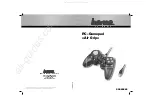
Flomatic Smart Card
TM
Model FDHC-100 (Digital High-Resolution Controller)
Configuration and Operation Manual
FDHC-100 Configuration & Operation Man. Rev 0
August 16, 2010
8 of 14
Flomatic Corporation
Glens Falls, NY 12801
Phone (518) 761-9797
Fax (518) 761-9798
the desired default position. When the LOSS OF COMMAND function is selected, the adjust buttons are
used to set the default position. The FDHC-100 indicates the selected default setting by flashing the
Open function indicator for the
open
default position, or it will flash the Close function indicator for the
closed
default position. When neither indicator is on, then the "last position" default is selected. When a
0-5V or 0-10V command signal is used, a loss of command signal cannot be detected. Therefore, if the
unit is configured for a 0-5V or 0-10V command signal (see COMMAND INPUT), the MODE button will not
select the LOSS OF COMMAND function.
AUX POSITION OUT CAL
Note that the AUX POSITION OUT CAL indicator also serves as a Fault indicator. When the indicator is on
steady, the AUX POSITION OUT CAL function is selected. When the indicator flashes, a Fault condition
has been detected (see FAULT INDICATOR for details). The AUX POSITION OUT CAL function is used to
calibrate an optional feedback transmitter output. An appropriate transmitter option module is required
to use this feature. When the AUX POSITION OUT CAL function is first selected (by pressing the MODE
button while in the LOSS OF COMMAND function), the CLOSE indicator will flash, and the voltage or
current associated with the
closed
position will appear at the option module output. If desired, the
output can be adjusted (using the adjust buttons) to any value from 0 to 10V (for a voltage output) or
0 to 20mA (for a current output). The new setting is then associated with the
closed
position. Pressing
the MODE button again will leave the unit in the AUX POSITION OUT CAL function except that the OPEN
indicator will flash, and the output voltage or current associated with the
open
position will appear at the
option module output. Like the
closed
setting, the output can be adjusted to any voltage (from 0 to 10V)
or current (from 0 to 20mA), and the new setting is then associated with the
open
position.
FAULT INDICATOR
The FDHC-100 detects various fault conditions that prohibit the unit from controlling the actuator. When
any of these conditions are detected, the Fault indicator will flash, and the motor outputs are turned off
until all fault conditions have been corrected. If an appropriate relay option module is installed, the Fault
relay output on the option module will also turn off. A communications option module can read the
specific condition(s) causing the fault. Note that a fault condition DOES NOT disable the motor outputs
when manually controlling the actuator with the adjust buttons; while useful for troubleshooting, care
should be exercised when operating the motor under a fault condition. The OVERRIDE mode can also
operate the motor when a fault condition exists – see OVERRIDE MODE for details. The various fault
conditions are described below:
LOSS OF COMMAND - If the command signal is disconnected or out of range, the fault indicator will
remain on until the signal is reconnected or back in range.
FEEDBACK POT FAULT - A fault condition is detected whenever the feedback signal is out of range (that
is, less than 5% of the potentiometer value or more than 95% of the potentiometer value), or when any
of the potentiometer connections are broken. Normal operation resumes when the potentiometer is
reconnected or back in range.
MOTOR 1 STALL - A fault condition is detected when no actuator motion is detected while the Motor 1
output is turned on. The fault condition will disable the Motor 1 output only, and the fault is cleared
when the FDHC-100 detects a motion greater than 1.5° in either direction. The fault can be cleared if 1)
the command signal commands a Motor 2 operation, 2) manual operation with the adjust buttons results
































